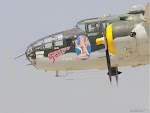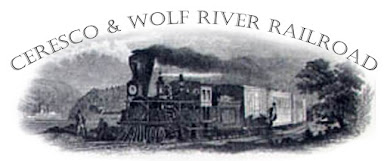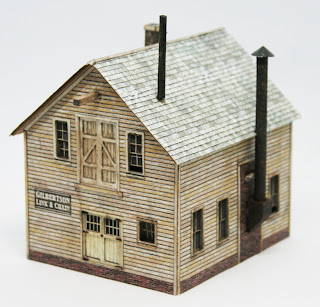"Every Model Railroad Should Have a History"
I read somewhere recently that every model railroad should have a history that gives it a reason to exist and real work to do. The following history is fiction, the backstory for my HO
Scale Ceresco & Wolf River Railroad. The
geography described conforms only loosely to the actual geography of
Wisconsin.
History of the
1867 to 1947
The village of Ceresco
(“Sĕ-RĔS-kō”),
named for the Greek goddess Ceres, was founded as a utopian commune in 1846 by
Fourierites from New York. They built several mills on Silver and Crystal
Creeks, established a school and post
office, and in 1854, founded a teachers’ college.
By 1850, the utopian
spirit had faded and the members divided the assets and became individual
landowners and business owners. With the arrival of the Waupun & Ceresco RR
from the south in 1858, Ceresco became a major shipment point for grain, flour,
milk, and other farm products bound for Milwaukee, Madison, and Chicago.
By
1867, Ceresco was a thriving agricultural community of mills, small factories,
and a prosperous main street. That year, six local businessmen applied to charter
the Ceresco, Wolf River,
The first rails were laid
from Ceresco in the summer of 1867. Winding its way around glacial moraines and
extensive wetlands, the line reached Scots’ Landing on Partridge Lake, in 1872.
From there steamboats of the Glencoe Navigation Co. plied the Wolf River,
supplying the lumber camps and sawmills, and bringing finished lumber,
shingles, farm products, venison, and furs to the railhead. The railroad
shortened by a week or two the time it took for products to reach markets to
the south – products that used to travel by steamboat to railheads in Oshkosh and
Fond du Lac.
The
Great Depression of 1873-1887 saw the failure of many short line railroads. The
Ceresco, Wolf River, & Lake Superior struggled on through the 1870s and
even managed to lay about 20 miles of track from Scots’ Landing in the general
direction of Ashland. But by 1878, the line was in receivership.
A group of investors from
Madison joined with mill owners on the Wolf River to purchase the CWR&LS
for about five cents on the dollar. They kept the line running with one aging
Porter, two sagging boxcars, and a ramshackle coach combine, hauling mostly
farm products and mail.
The return of prosperity
brought with it a flurry of railroad building and expansion. The CWR&LS
directors sought investors to extend the line to Ashland, but other railroads
and moguls with deeper pockets beat them to it. In 1889, with the writing on
the wall, the directors re-chartered the railroad as the Ceresco & Wolf
River. The line succeeded modestly for several decades as a small fish in a
large pond, upgrading track and equipment, and serving camps, mills, and farms
through its terminal at Scots’ Landing and its few miles of track north of
there.
In
1901, the directors purchased the Glencoe steamboat line to become the Ceresco
& Wolf River Railroad & Navigation Company. World War I increased the
demand for lumber and farm products, and the line did well financially until
the Crash of 1929. In receivership again, the line was absorbed in 1933, by the
Chicago & Northwestern Railway, which continued to run it under the Wolf
River banner as a shoestring operation.
By
then, the largest customer at Scots’ Landing was McIntyre Marine, a producer of
marine engines and hardware. A warehouse at the landing transshipped farm
products, wood products, and furs brought in on the steamboats. And the line’s
combine and gasoline speeder carried the mail and passengers to points along
the line.
When the United States
entered World War II, the mills and factories of Ceresco and Scots’ Landing
turned to war production. Traffic increased dramatically on the Ceresco &
Wolf River. The C&NW provided additional motive power and rolling stock to
help meet the demand. An 0-6-0 tank engine and an aging box cab diesel switcher pulled
short trains over the 45-mile line.
At the current time, in September
1943, the line runs two or three trains a day from Ceresco to Scots’ Landing
and back, exchanging cars with the C&NW and Milwaukee Road at Ceresco.
McIntyre Marine, Cape & Armstrong Warehouse, Wolf Brewery & Distillery, Armstrong Woolen Mill, and Mrs. Schnebley’s Sauerkraut factory are the largest customers along the line. Scots’
Landing has become a busy little market town, and the railroad also serves the many
small businesses there. From near Timid Falls, a short three-mile spur leads to the Turntail Brewery, maker of the popular "Scorned Woman Ale."
The future will not be kind to the little short line. A modern state highway will reach the Partridge Lake communities in the summer of 1946, and trucks will take away take much of the line’s business. A major flood in April 1947 will destroy the railroad’s aging wooden covered bridge over Dribbling Creek, and, rather than replace it, C&NW directors will abandon the line north of Dribble. The rails from Dribble to Scots’ Landing will be torn up and sold for scrap.
Local farmers will rally
to keep the line running on the remaining 27 miles north of Ceresco, but it won’t
last. With track and equipment in poor shape and modern roads paralleling the
line, the last Ceresco & Wolf River Train will roll into Ceresco on August 1st 1947.
In 2007, the former
Ceresco & Wolf River roadbed will be converted to a recreational trail,
with a new wooden pedestrian and bicycle bridge over Dribbling Creek. It will
become part of the national Rails to Trails network.














